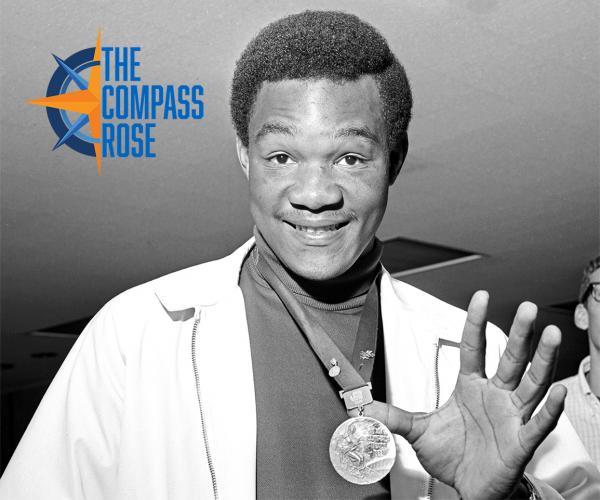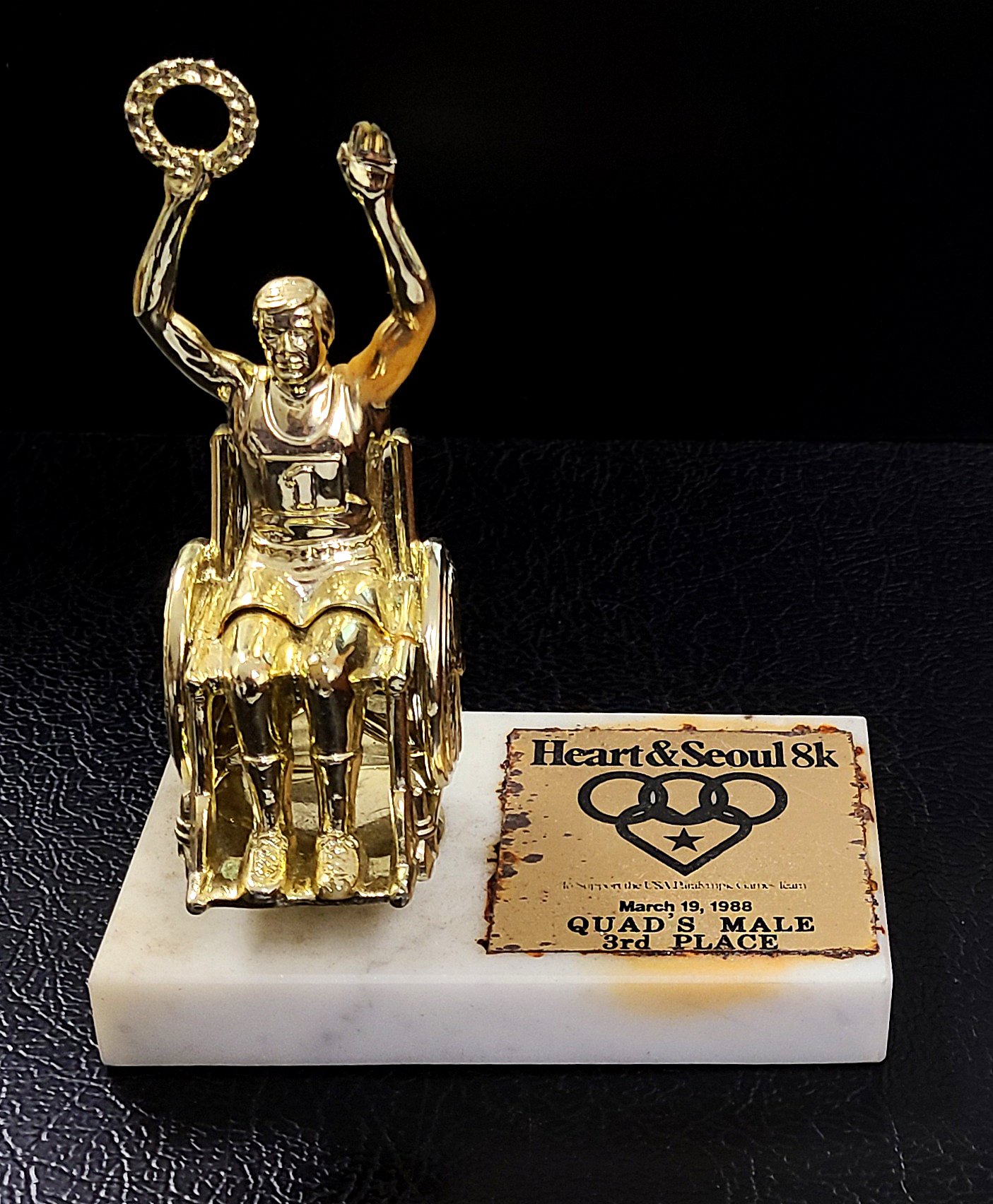
by Sara Pezzoni


by Sara Pezzoni
The purpose of The Compass Rose is to raise awareness of Special Collections' resources and to foster the use of these resources. The blog series also reports significant new programs, initiatives, and acquisitions of Special Collections.
Opening ceremonies for the Summer Olympics begin in Tokyo, Japan tomorrow! The Summer Olympics will be held from July 23-August 8, 2021. Tokyo will also be hosting this year’s Paralympics, which will be held from August 24-September 5, 2021. To celebrate, UTA Special Collections are highlighting the many different collections within our holdings that contain materials relating to the Olympics and Paralympics.
The Olympic Games, which originated in ancient Greece upwards of 3,000 years ago, were revived in the late 19th century and have become the world’s preeminent sporting competition. Today, the Olympics and Paralympics are international sporting events featuring summer and winter sports competitions in which thousands of athletes from around the world participate in a variety of competitions. Both the Olympic Games and Paralympics Games are considered the world's foremost sports competition with over 200 nations participating. The Olympics and Paralympics are normally held every four years, alternating between the Summer and Winter Olympics every two years in the four-year period.
The Olympic flame is one of the most prominent symbols of the Olympic Games. In Ancient Greek mythology, fire had divine connotations. The tradition of lighting a flame began in ancient Greece with the origins of the Olympics, when the flame was continuously burning throughout the events. Today, several months before the start of the Olympic Games, the Olympic flame is lit at Olympia, Greece. The torch-lighting ceremony starts the Olympic torch relay, which originated in 1936 before the Summer Olympics in Berlin, Germany. The ceremony formally ends with the lighting of the Olympic cauldron at the site of that year’s Olympic Games during the opening ceremonies.
The 1984 Summer Olympics torch relay took place from May 8-July 28, prior to the 1984 Summer Olympics in Los Angeles. The route covered around 9,300 miles across the United States and involved over 3,600 torchbearers. The torch made its way through Arlington and Fort Worth, as evidenced by these photographs from our collections.
A few years later, in 1996, the United States hosted its fourth Summer Olympics in Atlanta, Georgia, and these Games marked the centennial of the 1896 Summer Olympics in Athens. These photographs from our collections show torch bearing ceremonies once again coming through the DFW area, featuring torch bearers Edna Pemberton of Dallas, Texas and Dr. Allan Saxe of Arlington, Texas (and professor of political science at UTA).
In total, the torch was carried by 12,467 bearers that year, including 2,000 former Olympians or other people somehow linked to the Olympic movement, 5,500 people who had been nominated as "community heroes" by local United Way organizations, and 2,500 people selected by Coca-Cola and the Atlanta Committee for the Olympic Games. On its 84-day, 15,000-mile journey from Los Angeles to Atlanta, the Olympic torch passed through Fort Worth and Arlington on May 19, then Dallas on May 20. Each torchbearer ran about a kilometer, or 0.62 miles.
Mildred Ella “Babe” Didrikson Zaharias is considered one of the greatest athletes of all time who excelled in golf, basketball, baseball, and track and field. Zaharias' athletic career began with basketball in her hometown of Port Arthur, Texas, which led her to an Amateur Athletic Union (AAU) national title in 1931 as her team’s star player. The following year, at the AAU national track championships, Zaharias won five of the eight competitions she competed in. In 1932, Zaharias qualified to compete in the 1932 Summer Olympics, held in Los Angeles that year, and became the only athlete (male or female) to ever win individual Olympic medals in separate running, throwing, and jumping events. Zaharias set four world records at the Games, even breaking one of her own, and won two gold medals (80m hurdles and javelin throw) and one silver medal (high jump) for track and field. At the time, women were only permitted to enter three events in any Olympic Games. Following the 1932 Summer Olympics, Zaharias became a professional golfer and dominated the early professional women’s circuits, winning a total of 82 amateur and professional tournaments. Zaharias later pitched in several of Major League Baseball exhibition games.
See more items relating to Babe Didrikson Zaharias on the UTA Libraries Digital Gallery.
Bobby Morrow of San Benito, Texas, and a student at Abilene Christian College, established himself as a world-renowned track star after his performance at the 1956 Summer Olympics held in Melbourne, Australia. The men's track and field events were dominated by the United States at the 1956 Games, winning 15 of the 24 events and sweeping four of those events while taking first and second place in five others. Bobby Morrow led the way with winning three gold medals total from the 100- and 200-meter sprints as well as the 4x100 meter relay. Morrow also matched the world record of 20.6 seconds in the 200-meter sprints and helped set a world record in the 4x100 team relay.
Texas native George Foreman fought just 20 times in amateur boxing, with a 16-4 boxing record, before traveling to the 1968 Olympic Games in Mexico City, Mexico. Foreman competed in the National AAU boxing tournament in April 1968 and was one of 11 boxers in a record field of 280 who won division titles and automatic qualification for the Olympic trials. Foreman won a gold medal at the Summer Olympics that year in the heavyweight division against Soviet Union's Jonas Čepulis. Following the Olympics’ end, Foreman was photographed by Fort Worth Star-Telegram sports photographer Al Panzera at Dallas Love Field Airport on October 29, 1968 upon arrival to Dallas on a flight with other U.S. Olympians returning to Texas.
Doug Russell, a Midland, Texas native, attended UTA and swam for coach Don Easterling on the UTA Swimming and Diving Team. During his time swimming for UTA, Russell participated in the 1967 Pan American Games, where he won two gold medals in the 200-meter individual medley and 4x100-meter medley relay. He also won an NCAA national championship in the 100-yard butterfly in 1968, and Amateur Athletic Union (AAU) national outdoor title in the 100-meter butterfly.
Russell competed in the 1968 Summer Olympics, held in Mexico City, Mexico, where he won the first-ever gold medal awarded in the men's 100-meter butterfly—an event which made its debut at the 1968 Olympics—in an upset over U.S. teammate and favorite Mark Spitz. His time, at 55.9 seconds, set an Olympic record and fell just 0.3 seconds shy of Spitz’s world record. Russell won another gold medal at that year’s Games, swimming the butterfly leg for the winning U.S. team in the 4×100-meter medley relay. Russell, together with relay teammates Charlie Hickcox (backstroke), Don McKenzie (breaststroke), and Ken Walsh (freestyle), set a new world record of 3:54.9 in the event final.
"Doug Russell Day" was proclaimed on November 15, 1968 by UTA President Frank Harrison and Arlington Mayor Tom Vandergriff, in honor of UTA swimmer Doug Russell's win of two gold medals at the 1968 Olympics. Russell, who began his swimming career at "Alamo Pool" in high school while swimming for Midland High School, later had the pool renamed the Doug Russell Swimming Pool in his honor. Doug Russell Park, on the southern border of the UTA campus, was also named in his honor. Russell was inducted into the International Swimming Hall of Fame as an "Honor Swimmer" in 1985.
See more items relating to Doug Russell on the UTA Libraries Digital Gallery.
This Fort Worth Star-Telegram photograph, taken by sports photographer Al Panzera, shows the triumphant group of finalists in the United States Olympic boxing trials held at Texas Christian University’s Daniel-Meyer Coliseum (now Schollmaier Arena) on July 22, 1972. This group included, from left, Light flyweight David Armstrong, flyweight Tim Dement, bantamweight Ricardo Carreras, featherweight Louis Self, lightweight James "Bubba" Busceme, light welterweight Ray Seales, welterweight Jesse Valdez, light middleweight Reginald Jones, middleweight Marvin Johnson, light heavyweight Louis Slaughter, and heavyweight Duane Bobick. Four of those finalists won Olympic medals at the 1972 Summer Olympics held in Munich, Germany; Ricardo Carreras, Jesse Valdez, and Marvin Johnson each won a bronze medal, and Ray Seales won a gold medal, the only American to win gold in boxing that year.
Abu Yilla was raised in Great Britain and moved to the United States in 1984 to pursue a second bachelor's degree in Physical Education and play wheelchair basketball for the Freewheelers at UTA. Prior to moving to the U.S., Yilla played for Great Britain’s wheelchair basketball team in the 1984 Summer Paralympics held in the United Kingdom, but the team lost to the U.S. in the quarterfinals. Yilla competed in the 1988 Paralympics, held in Seoul, South Korea, for the U.S. track team and won a bronze medal in the 4x100-meter men’s relay. Yilla has also coached national and international championships in wheelchair rugby and has won 16 national championships in wheelchair basketball—eight in Great Britain as a player; five as a player, and three as an administrator in the U.S.
See more items relating to Abu Yilla in the Texas Disability History Collection and on the UTA Libraries Digital Gallery.

Heart & Seoul 8k trophy for third place, awarded to Abu Yilla on March 19, 1988 as part of a fundraising race to benefit the USA Paralympics team. Source: Abu Yilla Papers.
UTA alumnus Thomas Randall “Randy” Snow joined the UTA Freewheelers wheelchair basketball team in 1981 under coach Jim Hayes. In addition to Freewheelers games, Snow began competing in national and international wheelchair sporting events, which ultimately led him to winning a silver medal in the 1500-meter men's wheelchair exhibition event, the first of its kind, at the 1984 Summer Olympics held in Los Angeles. Snow was one of the eight athletes with disabilities that participated in the exhibition event and hoped to raise awareness about the sportsmanship and skills people with disabilities possess.
After graduating from UTA in 1986, Snow later went on to participate in the 1992 Summer Paralympics held in Barcelona, Spain and won two gold medals in men’s singles and men’s doubles tennis, and he also participated in the 1996 Summer Paralympics held in Atlanta and won a bronze medal in basketball. Snow won 22 major tournament titles during his career as a tennis player and was named USA Wheelchair Athlete of the Year in 2000. Snow was also the first Paralympian to be inducted into the U.S. Olympic Hall of Fame in 2004 and the second wheelchair tennis player to be inducted into the International Tennis Hall of Fame posthumously in 2012.
See more items relating to Randy Snow in the Texas Disability History Collection and on the UTA Libraries Digital Gallery.
Our holdings also include the work of long-time Fort Worth Star-Telegram editorial cartoonist Etta Hulme. Gifted to UTA from the Hulme family, this collection consists of over ten thousand original cartoons, sketches, and other artwork. Editorial cartoons can be both informational and entertaining, acting as both news sources and historical records of current events. Hulme used her art to illustrate major events in Fort Worth, Texas, and around the world. Throughout her decades-long career at the Star-Telegram, Hulme’s editorial cartoons did not shy away from controversial issues; her opinion on a variety of world issues were often reflective of public perception and the views of North Texans.
From 1976-1984, dozens of countries boycotted the Olympics for a variety of reasons, predominantly political in nature. In 1976, New Zealand's rugby team broke the international sports embargo on Apartheid South Africa, and as a result, 28 African countries retaliated by sitting out the following summer's Olympic games boycotts. Only 92 countries participated in that year’s Olympic Games, down from 121 in 1972 and the lowest number since the 1960 Rome Games in which 80 states competed.
At the following Summer Olympics, in 1980, U.S. President Jimmy Carter called for the United States team to boycott the 1980 Moscow Olympics in protest of the Soviet invasion of Afghanistan. Other countries including Japan, West Germany, China, and Canada joined in the boycott whilst others such as Great Britain and France sent a smaller number of athletes than usual.
In direct response to the United States boycotting the 1980 Olympic Games, the Soviet Union boycotted the 1984 Summer Olympics, which were being held in Los Angeles that year. The Soviet Union cited concerns over the safety of their athletes in what they called an anti-communist environment as their reasoning for boycotting the Olympic Games and Soviet-allied countries also joined the boycott. Despite the absence of the Soviets and their allies, the 1984 Games included 140 competing countries, with the U.S. team winning over 80 gold medals that year.
Once the boycotting of Olympics began to subside in 1988, Hulme later focused on calling attention to the flagrant commercialization of the Olympic games that became more apparent over the years.
Sources
Add new comment